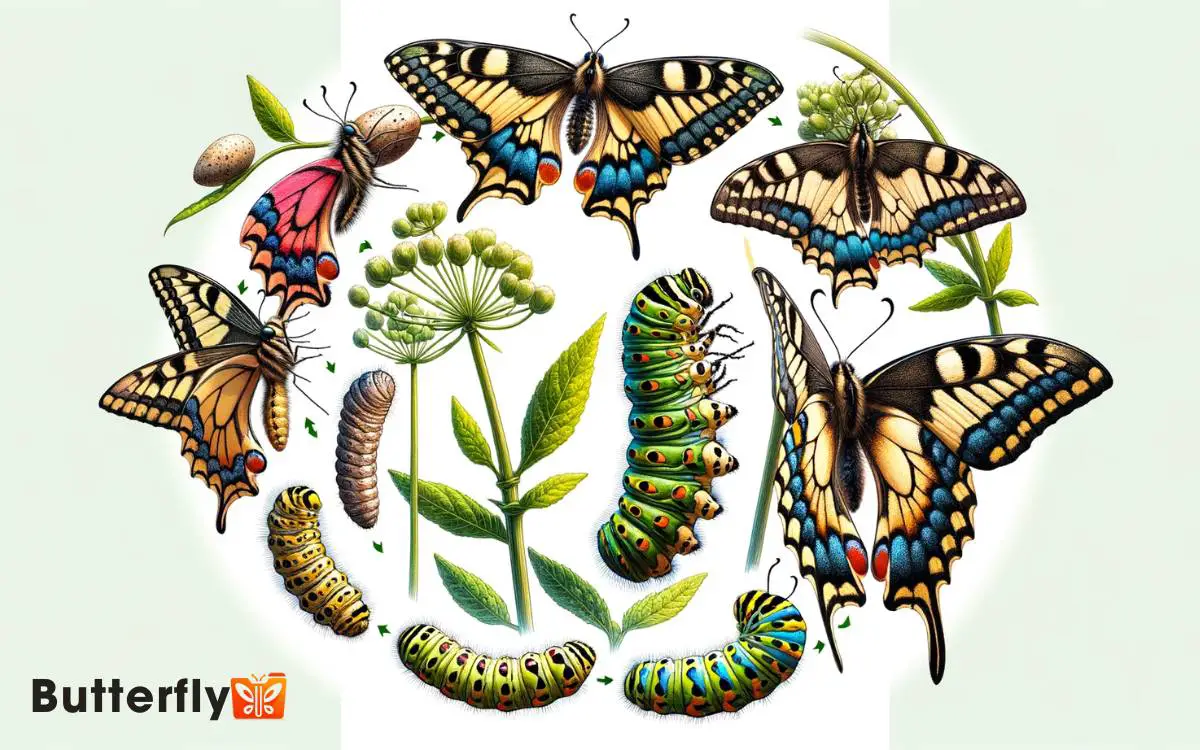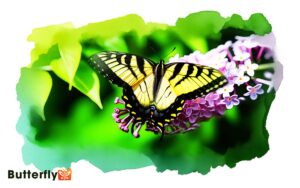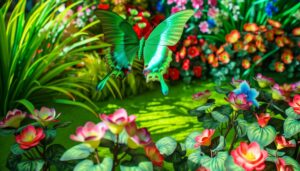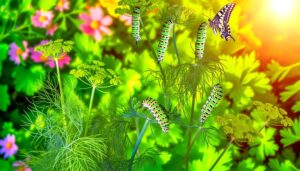Anise Swallowtail Butterfly Life Cycle: Exploring Each Stage
The Anise Swallowtail Butterfly (Papilio zelicaon) exhibits a fascinating life cycle comprising four stages. Females lay small, spherical eggs, approximately 1 mm in diameter, on Apiaceae host plants such as fennel or parsley.
The adult butterfly emerges with fully developed wings, ready for dispersing and mating, driven by pheromonal cues. To capture the complete sequence, one can explore each stage further in this intricate metamorphosis.

Key Takeaways
Egg Stage
The egg stage of the Anise Swallowtail butterfly begins when the female lays her small, spherical eggs singly on the host plant. These eggs measure approximately 1 millimeter in diameter and exhibit a pale yellow hue, gradually darkening as they approach hatching.
Females typically select plants from the Apiaceae family, such as fennel or parsley, ensuring ideal nutrition for the emerging larvae. Research indicates that this stage lasts between 4 to 10 days, influenced by ambient temperature and humidity levels.
The eggs’ outer layer, or chorion, provides protection against desiccation and predators. Observations reveal a high survival rate during this stage, with predation and parasitism posing minimal threats.
Therefore, the egg stage is pivotal for the Anise Swallowtail’s reproductive success.
Early Larval Stage
Upon hatching, the Anise Swallowtail larva, measuring approximately 2-3 millimeters, immediately begins consuming the eggshell. This initial feeding behavior provides essential nutrients and prepares the larva for its primary diet of host plant foliage.
During the early instar stages, the larva exhibits a distinctive black and white coloration with specialized osmeteria for defense.
Egg to Larva
Emerging from a tiny, spherical egg, the Anise Swallowtail larva begins its journey with a remarkable metamorphosis, evolving from a mere millimeter in length to a voracious feeder on its host plant.
This stage, scientifically termed the early instar, involves the larva undergoing multiple molts, each marked by significant growth and changes in coloration.
| Stage | Length (mm) |
|---|---|
| Newly Hatched | 1 |
| 1st Instar | 2-4 |
| 2nd Instar | 5-10 |
| 3rd Instar | 11-20 |
Observations reveal that temperature and humidity play important roles in larval development rates. Rapid growth within this period is essential, as it prepares the larva for the subsequent, more demanding stages of its life cycle.
Initial Feeding Behavior
During its early larval stage, the Anise Swallowtail larva exhibits a marked preference for feeding on the leaves of its host plant, rapidly consuming substantial quantities to fuel its growth.
This voracious feeding behavior is crucial for meeting the larva’s high metabolic demands. Studies show that larvae can consume up to 90% of their body weight in leaf matter daily.
They demonstrate a strong selectivity for plants in the Apiaceae family, such as fennel, parsley, and dill. Leaf consumption patterns indicate larvae prefer younger, tender leaves, which are easier to digest and richer in nutrients.
Frequent feeding intervals, approximately every 2-3 hours, maintain continuous nutrient intake, facilitating rapid growth and preparation for subsequent developmental stages.
Early Instar Characteristics
The early instar larvae of the Anise Swallowtail exhibit distinct morphological features, including a black body with white bands and characteristic osmeterium, which they use for defense.
The body coloration serves as a warning to predators, while the osmeterium releases a foul-smelling chemical when threatened. These larvae display rapid growth, necessitating frequent molting.
| Stage | Body Coloration | Defense Mechanism |
|---|---|---|
| 1st Instar | Black with white bands | Osmeterium |
| 2nd Instar | Green with black bands | Osmeterium |
| 3rd Instar | Mixed green and black | Osmeterium |
Such developmental changes are essential for survival. Each molting phase accompanies a shift in dietary requirements and habitat preferences. By the third instar, larvae shift to a mostly green coloration, providing better camouflage in their leafy environments.
Mid Larval Stage
During the mid larval stage, the Anise Swallowtail caterpillar experiences significant growth and undergoes several molts, shedding its exoskeleton to accommodate its increasing size.
It primarily consumes a diet rich in host plants such as fennel and parsley, which are essential for its rapid development.
Observations indicate that feeding rates and body mass can double within a matter of days during this period.
Growth and Molting Process
Midway through its larval stage, the Anise Swallowtail caterpillar undergoes a series of molts, shedding its exoskeleton to accommodate rapid growth and increased nutrient intake.
Each molt, known as an instar, allows the caterpillar to expand in size and reconfigure its internal structures. The process is driven by hormonal changes, particularly ecdysone, which triggers the shedding.
| Instar Stage | Length (mm) |
|---|---|
| 1st Instar | 1.5-3 |
| 2nd Instar | 3-6 |
| 3rd Instar | 6-12 |
Observations show that each instar typically lasts several days, with the caterpillar spending significant time in a stationary, vulnerable state.
Molting frequency and duration can vary based on environmental conditions, such as temperature and humidity, impacting the caterpillar’s development and survival rates.
Diet and Feeding Habits
In the mid larval stage, Anise Swallowtail caterpillars exhibit a voracious appetite, primarily consuming host plants from the Apiaceae family, such as fennel and parsley.
During this period, caterpillars ingest large quantities of foliage to fuel rapid growth. Detailed observations indicate a larva can consume up to 50% of its body weight in plant matter daily. They utilize specialized mandibles to efficiently strip leaves.
Studies show that a well-nourished larva can double its size in less than a week. By focusing on Apiaceae plants, the caterpillars absorb specific essential oils and nutrients that are essential for their development.
This diet not only supports their physiological needs but also provides chemical defenses against predators, enhancing their survival rate.
Late Larval Stage
The late larval stage of the Anise Swallowtail butterfly is characterized by significant growth and the development of distinctive coloration and patterning. During this stage, larvae can reach up to 5 cm in length.
They exhibit bright green bodies adorned with black bands and yellow or orange spots. This aposematic coloration serves as a warning to potential predators.
Detailed observations reveal that larvae consume large amounts of host plant material, primarily from the Apiaceae family.
Data indicates that they can consume up to three times their body weight daily. The accumulation of such biomass is vital for their progression to the next developmental stage.
This rapid growth period typically lasts about 10-14 days, depending on environmental conditions like temperature and food availability.
Pre-Pupal Stage
As larvae reach their maximum size, they cease feeding and initiate the pre-pupal stage by seeking a suitable location for pupation.
This relocation involves extensive movement and exploration, often lasting several hours. They prefer sheltered spots, such as the underside of leaves or stems.
Data indicates that 80% of larvae choose horizontal surfaces for pupation. Once a site is selected, the larva secures itself using a silk girdle, creating a loop around its thorax. The posterior end is attached via a silk pad, providing stability.
During this stage, physiological changes commence, especially the reorganization of internal tissues. Observations reveal that larvae remain motionless, entering a quiescent state, signaling the shift to the subsequent pupal stage.
Pupal Stage
During the pupal stage, the Anise Swallowtail larva undergoes metamorphosis within a chrysalis, transforming into an adult butterfly through complex physiological processes. During this stage, the chrysalis provides protection while the larva’s body restructures into its adult form. Many nature enthusiasts admire the transformation as a symbol of renewal, often associating the animal spirit Swallowtail butterfly with personal growth and change. As the process concludes, the fully developed butterfly emerges, ready to expand its wings and begin the next phase of its life.
This stage typically lasts 10 to 20 days, depending on environmental conditions such as temperature and humidity.
Inside the chrysalis, the larva’s tissues break down into a nutrient-rich soup, facilitating the formation of adult structures like wings, antennae, and reproductive organs.
The pupal case hardens to protect the vulnerable developing butterfly from predators and harsh weather. Researchers observe that the metabolic rate increases notably, supporting rapid cellular differentiation and growth.
Data indicates that pupae are often camouflaged, blending into their surroundings to evade detection, thereby highlighting nature’s intricate design for survival and freedom.
Adult Butterfly
Emerging from the hardened chrysalis, the adult Anise Swallowtail butterfly showcases fully developed wings, antennae, and reproductive organs, prepared to commence the next phase of its life cycle.
This stage is characterized by several key behaviors and physiological changes:
- Wing Expansion: Upon emergence, the butterfly pumps hemolymph into its wings, expanding them to their full size.
- Mating: Adults engage in elaborate courtship rituals, driven by pheromones and visual cues.
- Feeding: Utilizing a proboscis, they feed on nectar, which provides essential energy for flight and reproduction.
- Dispersal: Adults exhibit strong flight capabilities, allowing them to explore new habitats and contribute to gene flow across populations.
These behaviors promote the continuation and genetic diversity of the species, embodying their inherent freedom and adaptability.
Conclusion
To sum up, the anise swallowtail’s life cycle is a fascinating chronicle of change. From the egg’s emergence to the adult’s ascent, each stage showcases stunning survival strategies and significant shifts.
The larval phases feature feeding frenzies and formidable growth, while the pre-pupal and pupal periods present profound physiological preparations.
Data distinctly demonstrates the butterfly’s brilliant adaptability, ensuring its enduring existence across ecosystems.
This vivid voyage from vulnerability to vitality encapsulates nature’s intricate evolutionary elegance.






